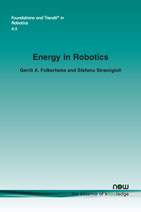Energy in Robotics
By Gerrit A. Folkertsma, University of Twente, The Netherlands, g.a.folkertsma@ieee.org | Stefano Stramigioli, University of Twente, The Netherlands, s.stramigioli@ieee.org
Abstract
Energy and energy exchange govern interactions in the physical world. By explicitly considering the energy and power in a robotic system, many control and design problems become easier or more insightful than in a purely signal-based view. We show the application of these energy considerations to robotics; starting from the fundamental aspects, but, most importantly, continuing to the practical application to robotic systems. Using the theory of Port-Hamiltonian Systems as a fundamental basis, we show examples concerning energy measurement, passivity and safety. Control by interconnection covers the shaping and directing of energy inside the controller algorithms, to achieve desired behaviour in a power-consistent manner. This idea of control over the energy flows is extended to the physical domain. In their mathematical description and analysis, the boundary between controller and robot disappears and everything is an interconnected system, driven by energy exchange between its parts.
Factor Graphs for Robot Perception
Energy and energy exchange govern interactions in the physical world. By explicitly considering the energy and power in a robotic system, many control and design problems become easier or more insightful than in a purely signal-based view.
Energy in Robotics presents a holistic, energy-based view of robotic systems. It examines the relevance of such energy considerations to robotics; starting from the fundamental aspects and proceeding to look at their practical application to robotic systems. Using the theory of Port-Hamiltonian Systems as a fundamental basis, it provides examples pertaining to energy measurement, passivity and safety. Control by interconnection covers the shaping and directing of energy inside controller algorithms, to achieve desired behaviour in a power-consistent manner. This idea of control over the energy flow is extended to the physical domain. In their mathematical description and analysis, the boundary between controller and robot disappears and everything is an interconnected system, driven by energy exchange between its parts.
